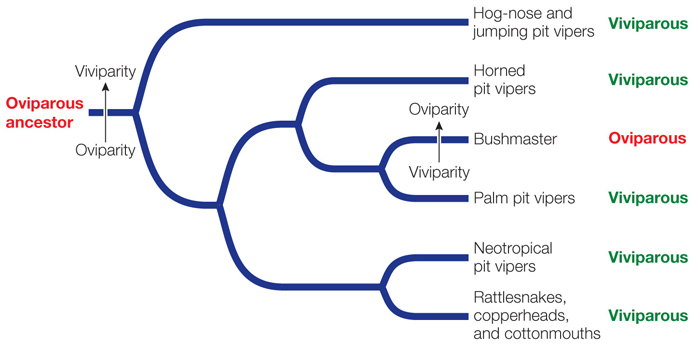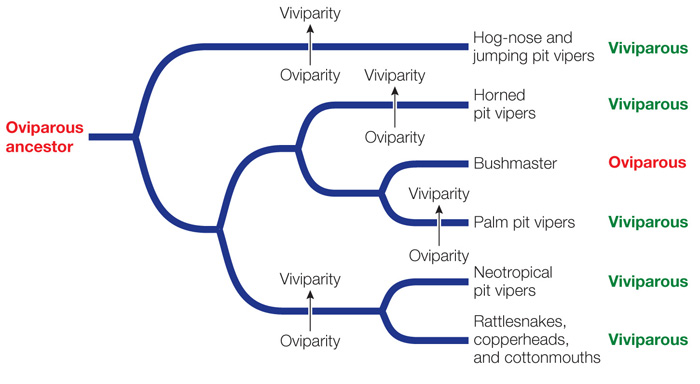Chapter 32
RECAP 32.1
Deuterostomes have radial cleavage, development of the blastopore into an anus (with formation of the mouth at the opposite end of the embryo from the blastopore), and development of the coelom from mesodermal pockets that bud off from the cavity of the gastrula. However, radial cleavage is thought to be the ancestral condition for all bilaterians and not unique to deuterostomes, as it is also found among some protostomes. The development of the blastopore into an anus is unique to deuterostomes, but it may also represent the ancestral condition for bilaterians.
DNA sequences of many different genes provide the strongest support for the monophyly of deuterostomes.
The three major groups of deuterostomes are echinoderms, hemichordates, and chordates. Sea stars are echinoderms, acorn worms are hemichordates, and humans, rattlesnakes, and tunas are chordates.
RECAP 32.2
Echinoderm larvae have bilateral symmetry, whereas the adults have pentaradial symmetry.
Sea lilies and sea urchins use their mucus-
covered tube feet to filter- feed by catching passing food particles, including phytoplankton. Sea cucumbers have anterior tube feet that are modified into large, sticky tentacles that can be protruded from the mouth to capture food, then withdrawn to wipe the food into the mouth. Many sea stars use their tube feet to grasp and pull open bivalves, then push their stomach into the bivalves to digest them. Like some echinoderms, hemichordates are filter- feeders, but they lack tube feet. Instead, they capture their food on a large, mucus- covered proboscis and then move the mucus and food by cilia into the mouth.
RECAP 32.3
Chordates are characterized by a dorsal hollow nerve cord, a post-
anal tail, and a notochord. Vertebrates have an anterior skull that encloses a large brain, an internal skeleton supported by the vertebral column, internal organs that are suspended in the coelom, and a well- developed circulatory system driven by a ventral heart. Hagfishes have a weak circulatory system with three accessory hearts (rather than a single, large heart). They have only a partial skull and a simpler brain than other vertebrates, and they lack separate, jointed vertebrae in their skeletal system. Because hagfishes lack fundamental traits shared by all other vertebrates, some biologists consider hagfishes to be the sister group of vertebrates, rather than a member of the vertebrates. Another possibility is that these traits in hagfishes have been secondarily lost or simplified.
The four appendages common to most vertebrates are the two pectoral appendages and the two pelvic appendages. In most swimming vertebrates, these appendages function as fins. They are commonly used for propulsion (especially the pectoral fins) but are also used for steering, stabilization, and manipulation of the body position in water. Among tetrapods, the appendages are often modified into limbs used for walking, running, jumping, burrowing, climbing, grasping, and manipulating objects. There have been several reversals to finlike limbs in aquatic tetrapods (several times among amphibians, turtles, birds, and mammals, for example). The pectoral limbs of tetrapods were modified into wings for powered flight in at least three different lineages (birds, bats, and the extinct pterosaurs). The limbs have been modified for gliding as well (in fishes, amphibians, lizards, and mammals). One or both pairs of appendages have been lost or greatly reduced in many groups of fish, amphibians, reptiles (including birds), and mammals. Some well-
known examples of limb reduction or loss include the completely legless caecilians and snakes, the loss of external hindlimbs in whales and manatees, and the greatly reduced forelimbs of flightless birds.
RECAP 32.4
Amphibians exchange gases and fluids through their permeable skin, which makes them highly vulnerable to many environmental toxins and some pathogens (especially an introduced chytrid fungus). Many species of amphibians have a biphasic life cycle, so they are vulnerable to habitat degradation and loss of both aquatic and terrestrial environments. Most amphibians do not move long distances, so they do not easily move into new habitats when their local environment is destroyed. For these reasons, they are also sensitive to rapid climate changes. Many species of amphibians have highly specialized habitat requirements and live in very restrictive ranges. Habitat loss or change within these restricted ranges often results in extinction.
The major mammal lineages rapidly diversified after the mass extinction event at the Cretaceous–
Tertiary boundary. The extinction of many large lineages of dinosaurs may have opened up opportunities for mammalian diversification. By this time, the major continents had separated by continental drift, so there were independent radiations of mammals in Laurasia, Africa, South America, Europe, and southeastern Asia. Fossil remains of extinct theropod dinosaurs show that many features once thought to be restricted to birds, such as feathers, actually evolved much earlier among the theropods. Other typical “bird” morphological features, such as air-
filled bones and a furcula (wishbone), are also typical of the larger group of theropods. Among living reptiles, DNA sequence analyses clearly unite birds with the crocodilians (the other living archosaurs). The combined evidence from many sources that birds are a surviving group of theropod dinosaurs is now overwhelming. Hair evolved in the ancestor of mammals; feathers evolved among theropod dinosaurs (seen today among the birds). Among the living tetrapods, birds and mammals are endothermic. Hair and feathers provide body insulation for mammals and birds, respectively. Without these forms of insulation, the maintenance of metabolic body heat would be difficult. Fossil evidence shows that many extinct theropod dinosaurs also had feathers, so many paleobiologists predict that they were endothermic as well. Endothermy would also be expected in large, active predators—
a description that fits our current view of many theropod dinosaurs.
RECAP 32.5
New World monkeys are all arboreal, and most have a long, prehensile tail that they use to grasp branches in climbing. Many Old World monkeys are more terrestrial, and they all lack a prehensile tail.
Changes in a regulatory gene that affects skull development resulted in delayed somatic development in humans (neoteny). This led to the evolution of adult human skulls that are shaped more like those of juveniles (with relatively large brains and small jaws). Thus the human skull increased in size without changing as much in shape as occurs in our closest relatives, the chimpanzees.
WORK WITH THE DATA, P. 700
The minimum number of changes is two, one of which is a reversal from viviparity to oviparity.


Four changes from oviparity to viviparity are required, or two additional transitions in reproductive mode compared with the answer to Question 1.
FIGURE QUESTIONS
Figure 32.17 Most adult frogs are insectivorous, but insects can be very limited during early spring or the beginning of wet seasons. By reproducing in the water, frogs can take advantage of an abundant seasonal resource (algal blooms in temporary water) as a food source for their offspring. This allows the developing tadpoles to specialize on an abundant resource until they are large enough to feed on insects.
Figure 32.19 In the amniote egg, nutrition is provided by the yolk sac, and the allantois functions in gas exchange and waste collection. The chorion holds all the various membranes together with the embryo, and also functions in gas exchange. The amnion provides structural support for the developing embryo. In viviparous species, the placenta provides nutrition, as well as gas and waste exchange, through the maternal circulatory system via the umbilical cord. Note that the yolk sac and allantois are involved in the makeup of the umbilical cord (retaining their roles in nutrition, gas exchange, and waste exchange), and the amnion and chorion retain their functions of structural support.
APPLY WHAT YOU’VE LEARNED
In Sceloporus lizards, there is a general trend toward viviparity occurring in colder (blue lineage) environments, with a few exceptions, lending support for the cold-
climate hypothesis. Viviparity is advantageous in cold environments because mothers can behaviorally maintain higher temperatures for developing embryos. In addition, increased maternal investment leads to larger offspring among viviparous lizards, so the young are more likely to survive the shorter growing season of cold environments. Advantages of viviparity: It can keep eggs safe. Behavioral thermoregulation can keep embryos at an optimal temperature for development. Increased maternal investment results in larger offspring that are more likely to survive the shorter growing seasons of cooler environments.
Disadvantages of viviparity: If the mother dies during the gestation, all the eggs die with her. Each female produces fewer offspring. Females are encumbered with the developing embryos, which can make escape from predators harder.
Advantages of oviparity: Females are freed from the weight of eggs, so they can reproduce more often and escape faster in response to predation attempts. They can also produce larger clutches of offspring.
Page A-36Disadvantages of oviparity: Developmental temperature of eggs is dependent on the nest site, which limits the temperature of development in colder environments. Females cannot continue to contribute resources to developing eggs, which results in smaller offspring.
In mammals, the evolution of viviparity occurred only once. In squamates, viviparity is estimated to have originated more than 100 times, so there is a larger sample size of independent events for testing hypotheses. The transition in mammals occurred more than 100 million years ago. Many of the transitions to viviparity occurred much more recently in squamates (see the Sceloporus phylogeny), making it easier to reconstruct the probable environmental conditions of the time.
(Answers will vary.) An appropriate study design should test or demonstrate that (1) females of viviparous species behaviorally thermoregulate, and internal body temperature is different from nest temperature of oviparous species, and (2) differences in incubation temperature affect the fitness of offspring. An example study design was used by Ji et al. (2007), who submitted females of the common sun skink (Mabuya multifasciata) to five different thermal regimes throughout their gestation period and compared female body temperatures across the thermal regimes and to those of nongravid females. The researchers also measured phenotypic and performance traits of the offspring to assess the relationship between fitness and developmental temperature.